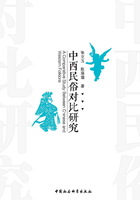
Chapter Three Customs of Costumes
1. General Introduction
The term costume, in a broad sense, refers to wardrobe and dress in general, or to the distinctive style of dress of a particular people, class, or period. And it may be used interchangeably with the word clothing, or clothes in this chapter.
Clothing wearing is the unique feature of human beings which differs ourselves from other animals. Meanwhile, it represents human social attribute. It is believed that man first employ animal skins and vegetation as coverings to protect ourselves from the awful climate such as cold, heat, rain and snow; alternatively, covering may have been produced first for other purposes, such as decoration, cult, or prestige, and later found its practicality as well. The progress of clothing is highly valued as a reflection of the materials availability to a civilization as well as the technologies that it has mastered. The social significance of the finished product absolutely reflects their culture.
(1)Origin
The exact time of man's first wearing clothes is still uncertain, roughly around 100, 000 to 500, 000 years ago, according to anthropologists. The first clothes came naturally: animal furs and skin, leaves and grasses, and bones and shells, which were simply draped or tied. Then 30, 000 years ago, needle work made out of animal bone present evidence of sewn leather and fur garments. Later on, the cloth making which was drawn on basketry techniques ap peared as one of human's distinctive technologies when settled neolithic cultures discovered the advantages of woven fibers over animal hides.
Later ages saw development on fabrics and textiles: flax fibers about 8, 000 B. C., with cotton following approximately 5, 000-4, 000 B. C. and wool around 3, 000 B. C. Meanwhile, other fibers such as reed, palm and papyrus were applied together with flax(linen)to make ropes and other textiles since 6, 000 B. C. Silk also was introduced as a fabric around 4, 000 B. C. in China. The Silk Route, which started in 114 B. C. during the Han dynasty, is viewed as one of the most important contributors to the development of the Chinese great civilizations. Together with Egypt, Mesopotamia, Persia, the Indian subcontinent and Rome, it helped to lay the solid foundations for the modern world.
(2)Forms
Costumes encompass four aspects, namely textiles, styles, colors and decorations. Traditional and characteristic costumes exist as the choice and combination of the four to people from different nationalities. The determining factors are as the following:
①Regions
This is the primitive and directive factor. For northerners from cold areas, furs and boots are their first choice while for folks from tropics, their clothes are characteristic of flax, silk, cotton which are usually short and pleasant to wear.
②Productive Methods
Distinct productive methods of the people lead to different clothing traditions. Simple clothes with furs are favored by nomads but elaborate and decorated cotton clothes may be preferred by people engaged in farming.
③Ethnic Psychology
Various tastes and aesthetical standards affect clothing traditions. For instance, white is always appreciated by Koreans whereas Han nationality favors red. Braid was once prevailing among ancient Khitans, Mongolians and Manchus while ancient Han nationality is unwilling to have hair cut for they believe their bodies, including hair, are precious heritage from parents.
④Religions
Religions exert impact on people's life, traditional clothes being no exception. Islam requires both men and women to be modest not only in behavior but in dress. Some Muslim women wear modest dress, or hijab, that covers most of the head and body. Buddhist nuns and monks wear robes in a variety of colors, from gray to orange, depending on their region and their tradition. In many cases, both nuns and monks in the Buddhist tradition shave their heads.
⑤Politics
Politics influences costumes substantially, sometimes even compulsorily. For instance, in ancient China, every dynasty transition involves changes of clothes, ranging from color to styles. Also the official clothing is ranked by distinctive color and patterns.
⑥Time Progress
The social development will definitely witness the progress of costumes. Take China for instance, costumes of Han nationality are once labelled as loose and large robes, Mandarin jackets to Chinese tunic suits. But nowadays the styles and patterns tend to be various and colorful.
⑦Alien Influence
Every nationality is inevitably influenced by foreign clothing customs while retaining its own characteristics. Suits, ties and evening gowns, which are exclusively worn by westerners now find their place in modern Chinese wardrobes.
(3)Functions
①Self-Protection
The protectional function of dress serves as practical and protective dress for individuals. The body needs to be kept at a moderate temperature to ensure blood circulation and comfort. People wear clothes with concerns such as durability, comfort, or ease of care in mind.
②Decoration
Decoration is a way individuals can express his or her own private style of cultural background. Decoration allows us to improve our physical charm, assert our creativity, single membership or ranking within a group or culture.
③Group Membership
People dress alike in order to prove that they belong to a specific organization or group. Clothing can be worn to identify with whom we affiliate. Uniform clothing can help in recognizing an individual's profession, religious affiliation, social standing or lifestyle.
④Ceremony
Ceremonial dress is that clothing has the functional method for people to take part in a specific type of ceremony or special event. A perfect example of ceremonial is a wedding or a graduation cap and gown.